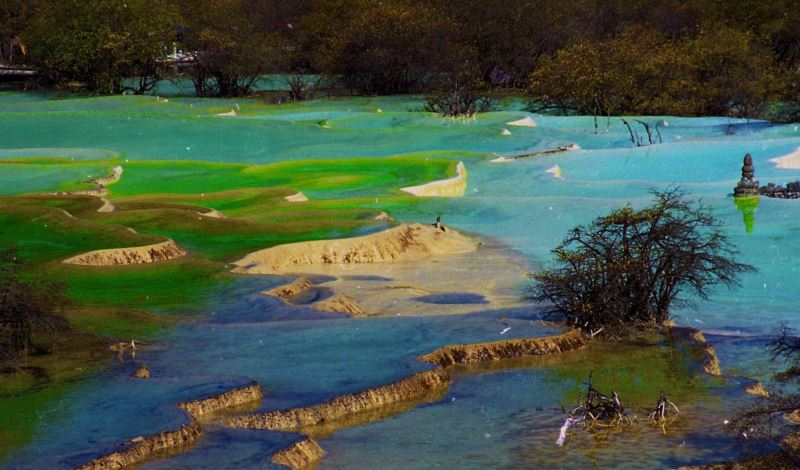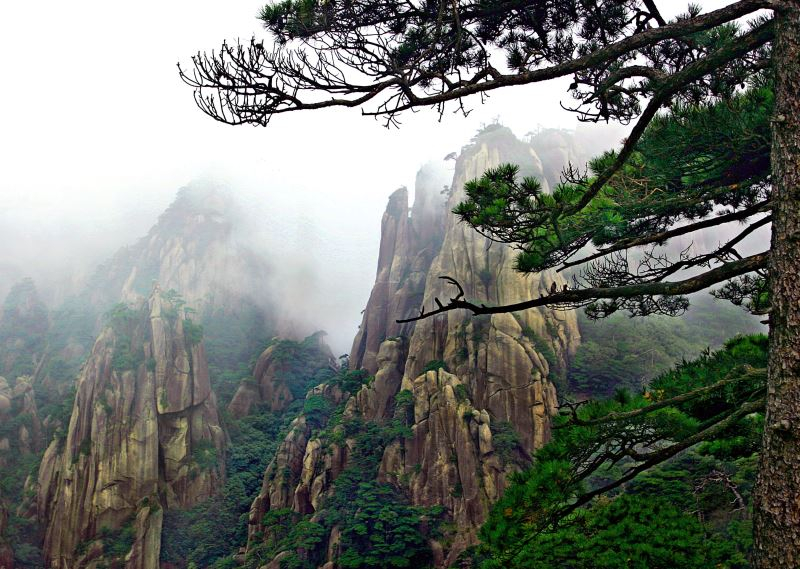
Holy Wonderland—Huanglong
Splendid
Chi Culture
Topic
Holy Wonderland—Huanglong
The main landscape of Huanglong (literally “yellow dragon”) in Sichuan is its large-scale, intricately structured and richly colored travertine; it became internationally known because of its rare karst topography. In 1992, both Huanglong and Jiuzhaigou were inscribed on UNESCO’s list of World Heritage Sites.
Huanglong is known for its “Four Exquisites”: colored ponds, snow-capped mountains, canyons, and forests. With the addition of its beach-streams, ancient monasteries, and folk customs, some people speak of the “Seven Exquisites.” The scenic sites consist of Huanglong Valley, Danyun (red cloud) Gorge, Mouni Valley, Xuebao Peak (the highest peak of the Min mountain range), Xueshan (snow mountain) Ridge, Hongxing (red star) Rock, and Xigou (west ravine). The main scenic area is located below Xuebao Peak facing the source of the Fu River. The area’s name comes from the way it appears if viewed from a great height. It has been described as looking like a golden dragon lying across the Canglong (hidden dragon) mountains. The name Huanglong has been hailed as the “symbol of China.”
The entire scenic route is about 7.2 kilometers—from the valley mouth 1,800 meters above sea-level, to the valley top at 3,430 meters. Visitors can walk along trails between the Golden-sand Pavement and the Thousand-ripples of Jasper Colored Water. Cable cars take visitors to the upper station where they can then walk to the valley top to enjoy more scenery. The major scenic spots include Peiyuan Bridge, Yingbin chi (welcoming-visitors pond), Feipu liuhui (marvelous flying waterfalls), Xishen dong (washing cave), Jinsha pudi (golden-sand pavement), Penjing chi (bonsai pond), Mingjing daoying chi (mirror-reflection pond), Suoluo yingcai chi (Shala tree color-reflecting pond), Qishu liufang chi (jade-tree lasting reputation pond), Longbei liujin pu (Gilded dragon-back waterfall), Jiexian qiao (Meeting immortal bridge), Zhengyan cai chi (Vying-beauty colored pond), Yucui cai chi (Jade-colored pond), Yingyue cai chi (Moon-reflection colored pond), Huanglong gusi (Ancient monastery), Wu cai chi (Multi-colored pond), and Wanglong ping (Dragon-viewing level ground).
The Mouni Valley combines the beauty of both the Jiuzhai and Huanglong valleys, but is even more pristine. Visitors can always enjoy its tranquility; even in winter, it is accessible and not frozen over as some other sites are. The Mouni Valley scenic area is situated in the southwest portion of Songpan county. The area abounds with forests, caves, and lakes, all of which set one another off wonderfully. The lakes compete favorably with the colored ponds of the Jiuzhai Valley, and the waterfalls at the calcified ponds vie with Huanglong’s Jasper Pond for most beautiful. There are two scenic spots that attract the most tourists: Zhaga waterfall and Second Lake. Under the reflection of the snow-capped ridges, the imposing mountains form a depression; when the breeze sweeps the area, it seems as if one is sent off through a tranquil realm.
The average elevation of the Huanglong scenic area is more than 3,000 meters. There, one can see the extensive development of what remains of a quaternary glacier, as well as modern glaciers and several glacier lakes. Snow-capped Peak, the main peak of the Min mountain range in Sichuan is also the far-most eastern peak of China’s modern glaciers; it is 5,588 meters above sea level, covered with snow year-round and surrounded by heavy mist. It is one of the seven sacred mountains of the Bon religion of Tibet. To the east is Hailuo mountain, called in Tibetan Shar Dong Ri (Summer morning and winter day). Countless Tibetans and Han Chinese go there every June 15th and 25th to pay homage to the mountain.
From a specially built observation deck on Snow Mountain Ridge, one can see across the top of Snow-capped Peak. At the top of the mountain are colored prayer-flags fluttering in the wind—these are placed by devout Tibetans expressing their worship of nature through wind.
To visit the Jiuzhao Valley and the Huanglong scenic area, one must pass through the ancient town of Songpan. Centuries ago, during the Tang dynasty (618–907), the city was established here on account of its strategic position. Soon, Tibetans, the Qiang, Muslims, and the Han were all living together. These groups influenced one another, and while the communities integrated, they each managed to maintain their own unique customs and characteristics. A favorite spot of tourists is the elegant Dejimeiduo Street, with its row upon row of Tibetan houses and the sounds of the local dialect in the air.




